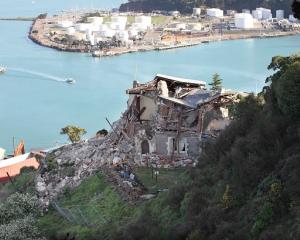
No one died in the tremors -- a magnitude 5.5 striking on the dot of 1pm and a nastier 6.0 one at 2.20pm, both centred 10km south of the city, a relieving contrast to the 6.3 magnitude quake on February 22 which killed 181 people.
But people were injured, buildings collapsed, power was cut to thousands of households and liquefaction bubbled up again, bringing further headaches to residents trying to get their lives back together.
Some houses were evacuated in beachside Sumner because of falling rocks, while part of one house was reported to have fallen down a cliff. The tower of Lyttelton's historic Timeball Station collapsed.
Christchurch Mayor Bob Parker echoed the rattled feeling immediately after the 6.0 aftershock.
"I don't know where that one has come from yet, but mate that was... that was very, very scary," he told Radio New Zealand.
The District Health Board reported two or three major cases of injury, but could not specify their nature. It said 12 people had been admitted to its hospitals while others were treated for minor injuries, many caused by debris falling from buildings.
Prime Minister John Key said the quakes were another blow to Christchurch residents, but would not weaken the Government's resolve to rebuild the city.
"I am sure they are over all of this and they want a sense of normality to return and I think we can all feel their frustration. But they've got to know that we stand beside them, that we are totally committed to rebuilding the city and I am sure these aftershocks will eventually settle down and normality will return."
A national state of emergency was not going to be invoked, while Mr Parker was considering whether to declare a local one.
Mr Key said the quakes were likely to be treated as new events for insurance purposes.
He had been assured that the Earthquake Commission (EQC) had already obtained sufficient reinsurance. The Government had also provided enough in the budget, he said.
It was a shaky first day on the job for Roger Sutton, chief executive of the Canterbury Earthquake Recovery Authority (Cera).
"I hadn't actually been in a four-storey building before in a proper shake and it's quite an uncomfortable feeling," he said.
The civil defence response was "like a well-oiled machine", he said.
"We all live here and we have to make the best of things and we have to bring the city back to what it was."
Two people were trapped when St John's Church in central Christchurch collapsed, but they were freed quickly.
Police evacuated the central city red zone after the 1pm quake.
About 150 to 200 people were in the red zone when the first aftershocks struck and it was fortunate none was hurt, Cera demolitions manager Warwick Isaacs told Radio New Zealand.
Masonry was falling from several stories up, he said.
He expected there would be a halt on work for "four or five" days, as the red zone -- crippled by the February 22 quake -- was now potentially dangerous.
Christchurch police reported a building collapsed on the corner of Stanmore Rd and Worcester St, but it was clear of people.
People attending the second inquest hearings for Christchurch earthquake victims were so upset when the 6.0 tremor struck, that the hearing was abandoned for the day about 2.30pm.
"The families were just devastated and went home," Vicky Cran told NZPA.
The inquest, looking into the deaths of 106 people when Christchurch's CTV building collapsed and caught fire in February 22's devastating quake, was adjourned due participants being upset by today's tremors, and fears the venue may be unsafe.
Photographer Pam Johnson told NZPA she was in the vicinity of Gloucester St and Latimer Square in the central city when the magnitude 6.0 quake struck and could hear constant sirens as the dust rose.
She could barely stand up as the quake struck, and there had been constant small aftershocks.
She had seen a man beside the road crying. "He said his house was ruined."
Liquefaction was reported at a number of locations, particularly in Sumner and Bexley, which both suffered badly in the earlier quakes.
Lyttelton Port of Christchurch said it had further damage today and it was assessing the extent over the next day.
Christchurch schools were told to stay closed tomorrow to allow building assessments to take place.
Orion said power was cut to about 56,000 households and businesses, just over a quarter of its Christchurch customers.
"Our teams are working to restore power as soon as possible, however access to some areas is difficult due to heavy traffic on the roads," Orion said.
Telecom and Vodafone reported heavy congestion on mobile and fixed networks and urged people to confine use to emergency calls and to use texting to conserve capacity on the mobile networks.
The NZ dollar dropped as the tremors hit with rate against the US dollar falling to US81.22c around 3.20pm, from around US82.15c before the series of quakes. It was US81.38c at 6.45pm.






